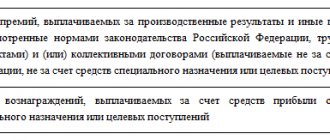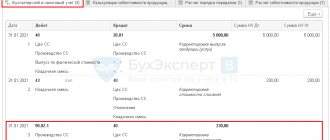Accrual of interest on deposits and issued loans - non-operating income
Every entrepreneur, when organizing his own business, strives for a single goal - to make a profit.
But for this you need to generate some income. Income can be received from the sale of products of own production, goods previously purchased for the purpose of resale, as well as from the performance of work and the provision of services. This concerns the main activity of an economic entity. But there is another type of income. Thus, an individual entrepreneur or organization can open a deposit account with a banking institution in order to receive additional funds in the form of accrued interest on the balance of this account. Additional income can also be obtained by issuing funds to other economic entities and charging the borrower interest for use. Accrued interest receivable on both deposits and loans issued will constitute so-called non-operating income, which must subsequently be taken into account when calculating income tax.
In the income tax return, the amounts of accrued interest receivable will be included in line 100 of Appendix 1 to Sheet 02.
What about the VAT return? Are the specified non-operating incomes included in it?
Attention: starting with the report for the 3rd quarter of 2022, it is necessary to use a new VAT declaration form, as amended by the Federal Tax Service order No. ED-7-3 dated March 26, 2021/ [email protected]
You will find a line-by-line algorithm with examples of filling out all twelve sections of the report in ConsultantPlus. Trial access to the system can be obtained for free.
VAT
When issuing a loan in cash for the amount of interest on it, there is no need to charge VAT (subclause 15, clause 3, article 149 of the Tax Code of the Russian Federation). The organization that issued the cash loan is also not obliged to issue invoices for the amount of accrued interest (subclause 1, clause 3, article 169 of the Tax Code of the Russian Federation).
Interest (both in cash and in kind) received from the borrower for using a trade loan is subject to VAT. Calculate this tax as follows:
| VAT | = | Interest received from the borrower | – | Interest calculated based on the refinancing rate in force during the period for which interest is calculated | × | 18/118 or 10/110 (depending on the type of property) |
Calculate the tax only after actually receiving the interest.
This procedure follows from subparagraph 3 of paragraph 1 of Article 162 and paragraph 4 of Article 164 of the Tax Code of the Russian Federation.
For the amount of interest subject to VAT, draw up an invoice in a single copy and register it in the sales book (clause 18 of section II of Appendix 5 to Decree of the Government of the Russian Federation of December 26, 2011 No. 1137).
An example of calculating VAT on interest on a loan in kind issued to an employee. Interest received in cash
On January 11, Alpha LLC issued manager A.S. Kondratiev trade credit (not a leap year). The subject of the contract is 1000 kg of lime worth 118,000 rubles. (including VAT - 18,000 rubles), return period is January 26 of the same year. According to the terms of the agreement, the borrower must pay Alpha an amount of 10 percent per annum for using the loan.
The Alpha accountant reflected the accrual of interest under the loan agreement as follows.
In January:
Debit 73-1 Credit 91-1 – 485 rub. (RUB 118,000 × 10%: 365 days × 15 days) – interest accrued on the loan for January;
Debit 51 Credit 73-1 – 485 rub. – interest received on the loan for January.
The amount of interest received, to the extent that it exceeds the refinancing rate, is included in the VAT tax base. The refinancing rate effective in January is 8.25 percent. The amount of interest calculated at this rate is: 118,000 rubles. × 8.25%: 365 days. × 15 days = 400 rub.
The amount of interest exceeding the interest calculated based on the refinancing rate was: 485 rubles. – 400 rub. = 85 rub.
The accountant calculated VAT on the amount of interest exceeding the refinancing rate as follows: 85 rubles. × 18/118 = 13 rubles;
Debit 91-2 Credit 68 subaccount “Calculations for VAT” – 13 rubles. – VAT is charged on the amount of income exceeding the interest calculated at the refinancing rate.
Invoice for the amount of 85 rubles. (including VAT - 13 rubles), issued in one copy, was registered by the accountant in the sales book.
An example of calculating VAT on interest on a loan in kind issued to an organization. Interest received in cash
On January 11, Alpha LLC issued a loan in kind to Proizvodstvennaya LLC (VAT payer). The subject of the contract is 12,000 sheets of galvanized iron in the amount of 600,000 rubles. (including VAT - 91,525 rubles), return period - until January 26 of the same year. According to the terms of the agreement, the borrower must pay Alfa an amount of 14 percent per annum for using the loan. It's not a leap year.
The Alpha accountant reflected the accrual of interest under the loan agreement as follows.
In January:
Debit 76 Credit 91-1 – 3452 rub. (RUB 600,000 × 14%: 365 days × 15 days) – interest accrued on the loan for January;
Debit 51 Credit 76 – 3452 rub. – interest received on the loan for January.
The amount of interest received, to the extent that it exceeds the refinancing rate, is included in the VAT tax base. The refinancing rate effective in January is 8.25 percent.
The amount of interest calculated at the refinancing rate is equal to: 600,000 rubles. × 8.25%: 365 days. × 15 days = 2034 rub.
The amount of interest exceeding the interest calculated based on the refinancing rate was: RUB 3,452. – 2034 rub. = 1418 rub.
VAT on the difference between the amount of interest calculated based on the interest rate and the amount of interest calculated based on the refinancing rate amounted to: 1,418 rubles. × 18/118 = 216 rubles;
Debit 91-2 Credit 68 subaccount “VAT calculations” – 216 rubles. – VAT is charged on the amount of income exceeding the interest calculated at the refinancing rate.
Invoice for the amount of 1418 rubles. (including VAT - 216 rubles), issued in one copy, the accountant registered in the sales book.
An example of calculating VAT on interest on a loan in kind issued to an employee. Interest received in kind
Alpha LLC issued manager A.S. Commodity loan to Kondratiev. On January 11, the borrower was given 500 sheets of galvanized iron in the amount of 29,500 rubles. The cost of one sheet is 59 rubles/sheet (the same as the book value).
Interest for using trade credit is set in kind (50 sheets of galvanized iron of the same quality). According to the terms of the agreement, Kondratiev is obliged to pay interest when repaying the principal debt. On January 26, the debt to the organization was repaid along with interest. It's not a leap year.
The Alpha accountant reflected the accrual of interest under the trade loan agreement as follows:
Debit 73-1 Credit 91-1 – 2950 rub. (59 rubles/sheet × 50 sheets) – interest accrued under the trade credit agreement;
Debit 10 Credit 73-1 – 2950 rub. – materials were received as payment for using trade credit.
The amount of interest received, to the extent that it exceeds the refinancing rate, is included in the VAT tax base.
The refinancing rate effective in January is 8.25 percent.
The amount of interest calculated at the refinancing rate is: RUB 29,500. × 8.25%: 365 days. × 15 days = 100 rub.
The amount of interest exceeding the interest calculated based on the refinancing rate was: 2950 rubles. – 100 rub. = 2850 rub.
The accountant calculated VAT on the difference between the amount of interest accrued based on the terms of the agreement and the amount of interest accrued based on the refinancing rate as follows: 2850 rubles. × 18/118 = 435 rubles;
Debit 91-2 Credit 68 subaccount “VAT calculations” – 435 rubles. – VAT is charged on the amount of income exceeding the interest calculated at the refinancing rate.
Invoice for 2850 rub. (including VAT - 435 rubles), issued in one copy, was registered by the accountant in the sales book.
An example of calculating VAT on interest on a loan in kind issued to an organization. Interest received in kind
Alpha LLC issued a loan in kind to Proizvodstvennaya LLC. On January 11, the borrower was given 500 sheets of galvanized iron in the amount of 29,500 rubles. (including VAT - 4500 rubles). The cost of one sheet without VAT is 50 rubles/sheet, with VAT – 59 rubles/sheet.
Interest for using trade credit is set in kind (50 sheets of galvanized iron of the same quality). It's not a leap year.
Under the terms of the agreement, the “Master” undertakes to pay interest upon repayment of the principal debt. On January 26, the debt to the organization was repaid along with interest.
The Alpha accountant reflected the accrual of interest under the trade loan agreement as follows:
Debit 76 Credit 91-1 – 2950 rub. (59 rubles/sheet × 50 sheets) – interest accrued under the loan agreement;
Debit 10 Credit 76 – 2500 rub. (50 rubles/sheet × 50 sheets) – materials were received as payment for using the loan;
Debit 19 Credit 76 – 450 rub. (2950 rubles - 2500 rubles) - reflects input VAT on the cost of materials received in payment of interest for using the loan.
The amount of interest received, to the extent that it exceeds the refinancing rate, is included in the VAT tax base. The refinancing rate effective in January is 8.25 percent.
The amount of interest calculated at the refinancing rate is: RUB 29,500. × 8.25%: 365 days. × 15 days = 100 rub.
The amount of interest exceeding the interest calculated based on the refinancing rate was: 2950 rubles. – 100 rub. = 2850 rub.
The accountant calculated VAT on the difference between the amount of interest accrued based on the terms of the agreement and the amount of interest accrued based on the refinancing rate as follows: 2850 rubles. × 18/118 = 435 rubles;
Debit 91-2 Credit 68 subaccount “VAT calculations” – 435 rubles. – VAT is charged on the amount of income exceeding the interest calculated at the refinancing rate.
Invoice for 2850 rub. (including VAT - 435 rubles), issued in one copy, was registered by the accountant in the sales book.
Situation: how to take into account when calculating income tax VAT, which was charged on the difference between the interest calculated under the trade credit agreement and the refinancing rate?
The amount of VAT accrued on the difference between the interest calculated under the agreement and the refinancing rate can be taken into account in reducing taxable profit.
The organization has the right to take into account as other expenses the amounts of taxes accrued as required by law (subclause 1, clause 1, article 264 of the Tax Code of the Russian Federation). An exception is the mandatory payments listed in Article 270 of the Tax Code of the Russian Federation.
Clause 19 of Article 270 of the Tax Code of the Russian Federation establishes that when calculating income tax, taxes imposed on the buyer (acquirer) of goods (work, services, property rights) are not taken into account. However, the accrual of interest under a loan agreement is not related to the purchase of goods (work, services, property rights). Consequently, the provisions of paragraph 19 of Article 270 of the Tax Code of the Russian Federation do not apply to relations under a loan agreement (accrual of interest under a loan agreement).
Since the Tax Code does not contain any other restrictions, the amount of VAT accrued on the difference between the interest calculated under the trade loan agreement and the refinancing rate can be taken into account in reducing taxable profit (subclause 1, clause 1, article 264, clause 1, art. 252 of the Tax Code of the Russian Federation). When applying the accrual method, do this immediately after VAT is accrued to the budget (subclause 1, clause 7, article 272 of the Tax Code of the Russian Federation). When using the cash method - after paying tax (subclause 3, clause 3, article 273 of the Tax Code of the Russian Federation).
However, it is possible that following this point of view may lead to conflict with inspectors. Arbitration practice on this issue has not developed.
If an organization decides not to take into account the accrued tax in reducing taxable profit, a permanent difference and a corresponding permanent tax liability will arise in accounting (clauses 4, 7 of PBU 18/02). Reflect its accrual by posting:
Debit 99 subaccount “Permanent tax liabilities” Credit 68 subaccount “Calculations for income tax” - reflects the permanent tax liability.
Deposit interest and VAT reporting: how they are related
By placing funds in a deposit account of a banking institution, the business entity remains their owner. The money must be returned by the bank upon expiration of the agreement. In accordance with Art. 39 of the Tax Code of the Russian Federation, such an operation is not recognized as sales. This means that interest accrued on the deposit is not subject to VAT, like amounts not related to sales. This is precisely the opinion expressed by officials of the Ministry of Finance in letter dated 10/04/2013 No. 03-07-15/41198. Thus, interest on deposit agreements does not need to be included in the VAT report.
You can read about how to prepare VAT tax reports correctly and without errors in this article.
Reflection of interest on loans issued in the VAT return
The situation is somewhat different with the interest that the lender accrues to the borrower when issuing loans in the form of cash.
According to sub. 15 clause 3 art. 149 of the Tax Code of the Russian Federation, the accrual of these interests is an operation exempt from VAT. It is for such operations that the tax report provides for Section 7, which contains four columns filled in as follows:
- column 1 - code 1010292 is given, designated “Loan operations in cash and securities, including interest on them...”;
- column 2 - the amount of accrued interest receivable is recorded;
- Columns 3 and 4 are crossed out.
EXAMPLE of filling out section. 7 when receiving interest on a loan from ConsultantPlus: The organization provides cash microloans to the population. The amount of accrued interest for the reporting quarter amounted to RUB 400,000. The organization will reflect this amount in column 2 of section. 7 declaration. For this activity, the organization rents premises from a VAT non-payer (the lessor applies the simplified tax system). Rental cost: RUB 30,000. per month, 90,000 rub. for the quarter. The organization will reflect this amount in column 3 of section. 7 declarations…. Read the continuation of the example by getting trial demo access to the K+ legal reference system. It's free.
More information about this section of the report can be found here.
According to paragraph 3 of Art. 169 of the Tax Code of the Russian Federation, the lender does not need to issue invoices for the amount of interest accrued under loan agreements.
NOTE! When simultaneously carrying out transactions that are subject to VAT and exempt from this tax, the taxpayer must maintain separate accounting, the principles of which must be outlined in the accounting policy.
Is receiving a loan subject to VAT?
If you received a loan in cash or securities, then you do not have any VAT obligations (clause 1, clause 3, article 39, clause 1, clause 1, clause 2, article 146 of the Tax Code of the Russian Federation).
When receiving other property under a loan agreement, there is also no need to charge VAT, since you do not have a taxable object (clause 1 of Article 146 of the Tax Code of the Russian Federation). However, when returning it, you must calculate VAT, since its return transfer is recognized as a sale (clause 1, article 39, subclause 1, clause 1, article 146 of the Tax Code of the Russian Federation).
Results
The accrual of interest on deposits and issued loans is non-operating income for taxpayers on the OSN. This income is taken into account when calculating the income tax base.
Transactions to receive the specified interest will not be subject to value added tax.
In one case, due to the fact that the amounts are not related to sales, therefore deposit interest is not reported in VAT reporting, and in the other, due to the fact that the operation is exempt from VAT due to the norms of the Tax Code of the Russian Federation, interest on loans issued will be reflected in section 7 of the VAT tax report. You can find more complete information on the topic in ConsultantPlus. Free trial access to the system for 2 days.





